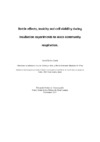Identificador persistente para citar o vincular este elemento:
https://accedacris.ulpgc.es/jspui/handle/10553/11392
| Título: | Bottle effects, toxicity and cell viability during incubation experiments to asses community respiration | Autores/as: | Baños Cerón, María Isabel | Director/a : | Arístegui Ruiz, Javier Montero del Pino, María F. |
Clasificación UNESCO: | 251001 Oceanografía biológica | Fecha de publicación: | 2012 | Resumen: | Microbial respiration is a key metabolic process in the ocean carbon cycle. However, so far there is not a “gold standard” method to estimate respiration in the sea. Direct oxygen consumption “in vitro” methods rely on long incubations (24h) inside glass bottles, which may enhance changes in the enclosed natural populations. Recently, an enzymatic in vivo ETS assay has been proposed as an alternative to estimate “actual” respiration in shorter incubation periods (<6 h). Here we have investigated two main factors that we consider may affect incubations in both the “in vitro” oxygen consumption experiments and the “in vivo” ETS assays: (i) The effect of enclosing natural population in bottles of different volume (125, 250 and 1000 mL) during 24 h, and (ii) The potential toxic effect of the INT (which is reduced to INT-F during the ETS assay) over natural populations, during the incubation period. We tested the “bottle effect” in the whole planktonic community (C) as well as in the filtered (through 1.2 μm filter) microbial community (F), along three experiments. Our results show variable responses of natural communities during the incubation inside bottles, but without any significant difference between the bottles’ volume used. The general pattern of these changes (both in the total and fractionated communities) is a moderate decrease in phytoplankton populations and a sharp increase in bacterial assemblages (favouring the growth of HNA cells), which would presumably affect the final metabolic rates. On the other hand, we tested the toxicity of the INT during a typical in vivo ETS assay (6 h incubation, 0.2 mM INT). The results of this single experiment show that, after the INT addition, there is (i) a complete loss of Prochlorococcus cells, and a moderate loss of Synechococcus and picoeukaryotes, (ii) an increase in HNA bacteria (presumably by the uptake of newly organic substrates from phytoplankton death) but a decrease in LNA bacteria, and (iii) a decline in bacterial viability, which is produced in the first 0.5 h, superimposed to the growth of HNA bacteria. In summary, our results highlight the importance of monitoring the evolution of microbial communities along incubations (both in the “in vitro” oxygen consumption experiments and “in vivo” ETS assays) and warn of some important methodological constraints that may drastically influence the actual respiratory rates. | Departamento: | Biología | Facultad: | Facultad de Ciencias del Mar | Instituto: | IU de Oceanografía y Cambio Global | Titulación: | Máster Universitario en Oceanografía | URI: | https://accedacris.ulpgc.es/handle/10553/11392 | Derechos: | by-nc-nd |
| Colección: | Trabajo final de máster |
En el caso de que no encuentre el documento puede ser debido a que el centro o las/os autoras/es no autorizan su publicación. Si tiene verdadero interés en el contenido del mismo, puede dirigirse al director/a o directores/as del trabajo cuyos datos encontrará más arriba.
Vista completaVisitas
129
actualizado el 04-may-2024
Descargas
222
actualizado el 04-may-2024
Google ScholarTM
Verifica
Comparte
Exporta metadatos
Los elementos en ULPGC accedaCRIS están protegidos por derechos de autor con todos los derechos reservados, a menos que se indique lo contrario.
